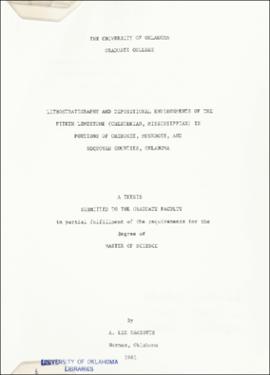| dc.contributor.author | Nageotte, A. Lee | |
| dc.coverage.spatial | Oklahoma. | |
| dc.coverage.spatial | Oklahoma. | |
| dc.coverage.spatial | Oklahoma. | |
| dc.date.accessioned | 2021-02-19T18:00:18Z | |
| dc.date.available | 2021-02-19T18:00:18Z | |
| dc.date.created | 1981 | |
| dc.date.issued | 1981 | |
| dc.identifier.uri | https://hdl.handle.net/11244/328593 | |
| dc.description | Thesis (M.S.)--University of Oklahoma, 1981. | |
| dc.description.abstract | This thesis provides a detailed lithostratigraphic analysis and interpretation of depositional environments of the pitkin limestone (Chesterian, Mississippian) in a portion of northeastern Oklahoma. The study area is located mostly in Cherokee County but also includes portions of Muskogee and Sequoyah Counties. Twenty-eight stratigraphic sections were measured and studied.
The Fayetteville Shale, which immediately underlies the Pitkin, was found to have a highly variable thickness in northeast Oklahoma. An adequate explanation of this feature is not possible at this time. The two fonnations are thought to have been at least in part deposited contemporaneously. Together they form a shoaling upward sequence.
Eleven facies were delineated in the study area: (1) Oolite Facies, (2) Oolitic Facies, (3) Bioclastic Facies, (4) Encrinite Facies, (5) Oncolitic Facies, (6) Nodular Limestone and Shale Facies, (7) Wackestone Facies , (8) Peloidal Facies, (9) Mudstone Facies, (10) Shale Facies, and (11) Mound Facies. Most of the Pitkin lithofacies were deposited in high energy shallow marine environments. The distribution of these facies and their inferred depositional environments
suggest that the Pitkin was a platform carbonate.
An unconformity of regional extent separates Mississippian and Pennsylvanian strata on the Ozark Uplift and is easily recognized in the field because of the contrast between the light gray-weathering limestones of the Pitkin and the brown weathering sandy grainstones of the overlying Sausbee Formation (Lower Pennsylvanian). The Sausbee locally has at its base a cobble conglomerate of Pitkin Limestone clasts. A pre-Pennsylvanian north-south trending fluvial valley feature, with a regional relief of at least 60 feet, can be delineated in Cherokee and northern Sequoyah Counties by cross sections and isopach maps of the Pitkin. The Pitkin is locally removed within the study area with the Sausbee resting directly on the Fayetteville Shale.
The conformable Chesterian stratigraphic sequence of Hindsville-Fayetteville-Pitkin in the Oklahoma Ozark Region may represent a carbonate shelf cycle or mesothem. The Hindsville is interpreted as a transgressive unit, the Fayetteville as being both transgressive and regressive, and the Pitkin as a regressive carbonate unit. Depositional strike of the Pitkin Limestone shifts from northwest-southeast in Muskogee and Wagoner Counties, Oklahoma to northeast-southwest in Washington and Crawford Counties, Arkansas as a result of a positive topographic expression of the Ozark Uplift in Oklahoma. | |
| dc.format.extent | x, 197 leaves | |
| dc.format.medium | x, 197 leaves : ill. (3 fold. in pocket) ; 29 cm. | |
| dc.language.iso | eng | |
| dc.publisher | Norman : [s.n.], | |
| dc.subject | Limestone--Oklahoma | |
| dc.subject | Geology, Structural--Oklahoma | |
| dc.subject | Facies (Geology)--Oklahoma | |
| dc.subject | Geology, Stratigraphic--Mississippian | |
| dc.title | Lithostratigraphy and depositional environments of the Pitkin Limestone (Chesterian, Mississippian) in portions of Cherokee, Muskogee, and Sequoyah Counties, Oklahoma | |
| dc.type | Text | |
| dc.contributor.committeeMember | Manger, Walter | |
| dc.contributor.committeeMember | Harper, Charles | |
| dc.contributor.committeeMember | Sutherland, Patrick K. | |

